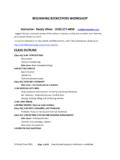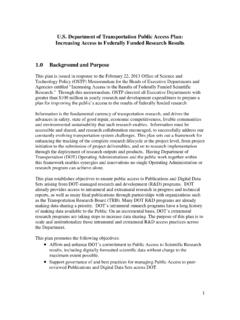Transcription of Beyond Taktic® Beekeeper-funded Research
1 Beyond Taktic Beekeeper-funded Research Randy Oliver First published in ABJ January 2017 The miticide Taktic has been the savior of the commercial bee industry since the early 2000s. But it may be time to move on. I ve been experimenting with a promising potential replacement. OUR SITUATION As I recently pointed out, there are signs that mites in areas of the are exhibiting some degree of resistance to Taktic s active ingredient--amitraz. And since Taktic has been pulled from the market, some beekeepers are justifiably concerned that the EPA may stop looking the other way about them illegally using the product (Canada s already hit one beekeeper with a hefty fine; no telling when some State enforcement branch will make an example of a beekeeper). I m freshly returned from the California State Beekeepers Assoc. conference, where Dr. Juliana Rangel presented the findings of her student Liz Walsh (who previously found negative effects on queens from residues of miticides in the comb).
2 Liz recently found that field-realistic residues of amitraz in queen cell wax appeared to reduce the egg laying rate of queens reared in those cells. I ve suspected something like this, since queen problems appear to have increased since the widespread adoption of amitraz as a miticide. Of further concern is that amitraz residues are increasingly being detected in honey. In any case, commercial beekeepers are (or I suspect will soon be) looking for alternatives to Taktic. THE IDEAL TREATMENT In this same issue of ABJ, I m pushing our industry to get serious about shifting to mite-resistant stocks so that we can give up treatments altogether. But I know that my own operation would collapse if I were to attempt an abrupt transition, and have no doubt that most others would too. So although I don t use amitraz in my own operation, I have a common interest with my professional brethren to find mite treatments that are cheap, don t harm the bees, queen, or brood, and don t get into the honey.
3 My sons and I have managed so far with Apiguard thymol gel, MAQS formic acid strips, and oxalic acid dribble (still not yet registered in California, thus unhappily making me a pesticide scofflaw too). I previously reported on last summer s trials, in which we found Apiguard to be quite effective if applied in a 1 rim. MAQS can also provide excellent mite reduction, although there are occasionally issues with it knocking out poor or aged queens (perhaps not a bad thing). We love oxalic acid, but neither the dribble nor vaporization is effective if the colony contains much brood. As I reported last year, I had tried a new extended-release formulation of oxalic acid to overcome that problem [1]. In our initial small test, the results were so promising that I could hardly wait until this summer to work with it more seriously. The results are so encouraging that I wrote this lengthy step-by-step, picture-rich article to fully share what we learned.
4 OXALIC ACID/GLYCERIN STRIPS Oxalic acid dissolves to some extent in water, but has a notable fondness for glycerin. This makes food-grade glycerin an attractive carrier for oxalic acid in the hive, especially since its oily nature also confers upon it an affinity for bee (and mite) cuticle (Figs. 1 & 2). Figure 1. These wonderful photomicrographs by German beekeeper Bernhard Heuvel show the sticky tarsal pads which the mite uses to get a grip on the bee. Photos courtesy of Bernhard Heuvel. Figure 2. It has yet to be confirmed, but perhaps, as it moves over a bee carrying oxalic residues on its exoskeleton, the mite absorbs the acid through the thin cuticle of these pads. (Findings by Dr. Dennis van Engelsdorp suggest that acids may also affect the mites sensory papillae.) Since my first trial of OA/gly strips last fall (using Fernando Estaban s formula), my good friend Juanse Barros in Chile tested them extensively, and was also impressed.
5 Practical application: by dissolving oxalic acid into glycerin, and then saturating a cardboard strip with the solution, one can obtain an extended release application method for the acid into the hive, thus continually killing mites over more than one reproductive cycle, thereby overcoming the limitation of the dribble or vaporization application methods. By this time, an Argentine group started selling a formulation, Aluen CAP. The product was extensively tested by Mat as Maggi [2], with astounding results excellent mite control, no adverse effects on the bees, and no residues in the honey (plus it s considered as an organic treatment). Almost too good to be true! So when it came time for late summer mite control, I was ready to test it more extensively. TRIAL #1 We set up a yard of 28 hives of moderate strength, containing 2nd-yr queens, in which we had intentionally allowed mites to build to high levels (I wanted mite-stressed, old-queen hives to best detect any adverse effects from the treatments).
6 Scientific note: one gets much better efficacy data if treatments are tested on colonies that have high mite counts at the beginning of the trial. However, if the trial is to run for an extended period, the issue arises that the untreated controls may collapse from mite overload before the trial is over. But this creates another potential issue when one later applies the Henderson-Tilton formula to calculate treatment efficacy. This is because of mite drift from the high-mite test hives into the low-mite controls. The movement of mites carried by drifting bees is akin to the process of diffusion invariably moving from hives with high mite density to those with lower mite density. This can result in increasing the apparent rate of mite increase in the Control hives relative to that of the Treated hives, thereby artificially skewing the final calculation of efficacy upward. Thus, in calculating efficacy, one should be sure to limit the apparent rate of mite growth in the Controls against the biologically-limited maximum daily intrinsic rate of increase [3].
7 We ran positive controls of Apiguard and MAQS, as well as untreated negative Control hives (Table 1, Figs. 3-7). Since this was intended to be only a preliminary and exploratory quick and dirty testing of various methods of application of the OA/gly formulation, we used low numbers of hives in each group. What I was looking for were substantial and consistent differences rather than trying to tease out slight statistically significant effects. Table 1. The treatments. This was a preliminary "quick and dirty trial, so we used low n s. We used a slightly different OA/gly ratio than did Maggi [4]. We waited for a window of hot weather, since that is often a limiting factor for us (Fig. 3). Figure 3. The trial ran from June 28 through September 13, with daytime temperatures often in the high 90s. Figure 4. All hives were double deeps. Here we re placing two strips per box, over brood frames.
8 For an absorbent cardboard, I used strips cut from egg carton lids. Figure 5. Here we re placing 4 strips per box (8 per hive), distributed for maximum bee exposure. Figure 6. I was curious whether the bees would tug the OA/gly-soaked cotton fibers from facial pads and thus drag the solution over the bodies of other bees. (Result: they didn t touch the pads). Figure 7. The beekeepers favorite, the blue shop towel. I wondered whether bees would expose themselves to the OA/gly in the process of removing the towel. (One result: it did not help to cut slits in the towel that allowed the bees to remove it too quickly). RESULTS OF THE FIRST TRIAL As expected, the mites increased at a normal rate in the Controls, and Apiguard reduced mite levels quickly, after which they resumed a normal climb. The oxalic strips took longer to drop the mite counts, taking two months for full effect (Figs.)
9 8 & 9). Figure 8. The alcohol counts for the groups at each time point. I took Day 77 counts only for the 4-strip group note how the mite count had begun to climb, suggesting that the effect of the strips starts to wear out after two months. See the next figure for normalized results for easier comparison of treatment effect. Figure 9. I normalized the results (so that they all start at 100%) and added standard error bars. Of the oxalic acid treatments, the winner was the 4-strip group, although the shop towels didn t do too badly. I inspected the colonies regularly throughout the course of the trial. At these high temperatures, both the Apiguard and mixed essential oil treatments were hard on the bees (colonies tended to move their broodnests away from both treatments) [5], although the Apiguard hives quickly recovered once the bees removed the last of the gel after 20 days. The efficacy of the mixed essential oil pads was unimpressive.
10 It was (not unexpectedly) too hot for MAQS, even applied as single strips, which set the colonies back, although treatment did reduce the mite level. I was pretty stoked about the 4 OA/gly strip treatment--not only did it control the mites (with time), but the colonies thrived during treatment (Figs. 10 & 11). 0%50%100%150%200%250%300%350%400%Control (3)2 OA strips (4)4 OA strips (4)OA facial pads (4)OA shop towels (4)MAQS (3)Apiguard (3)Ess oil pads (3)Percent of original mite level 2016 Hot Weather Trial--Normalized Day 0 Day 27 Day 42 Day 57 Day 77 Figure 10. A brood frame with an OA/gly strip at right, two weeks after insertion. The colonies consistently reared brood right up to the strips. To my surprise, the bees and brood appeared to thrive in the acid-rich environment for the duration of the summer, and were some of my best looking hives come fall.. Figure 11. There was little chewing of the strips, and all remained intact for the entire summer (still tasting of acid).








